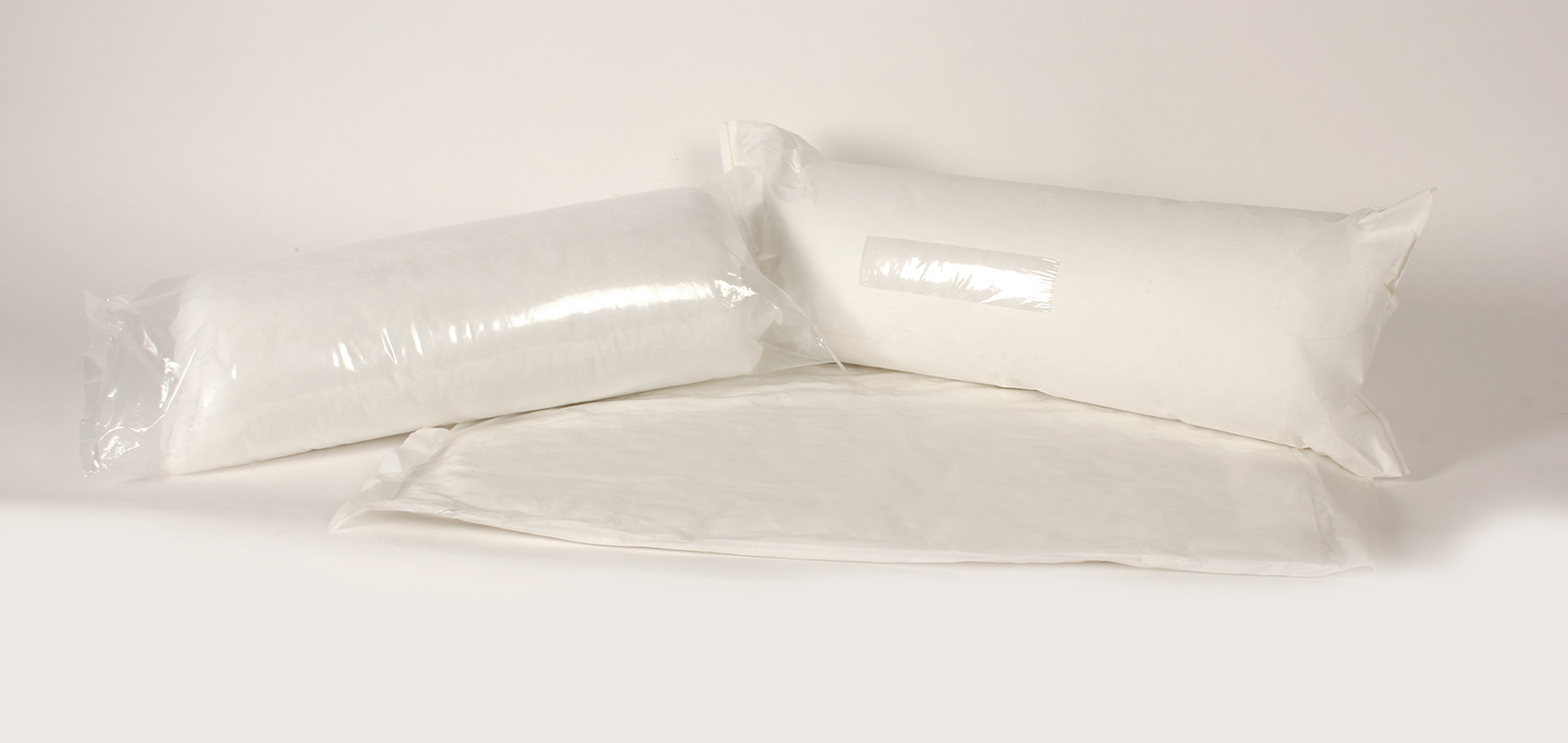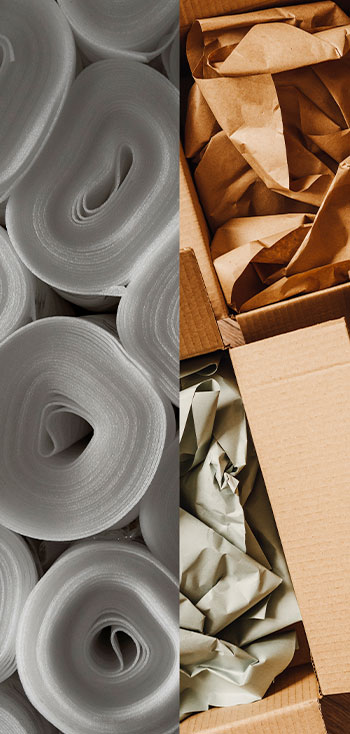PAPER OR PLASTIC? THAT IS THE QUESTION. OR IS IT?

The bedding sector is becoming very receptive to the sustainability-oriented practices that have been taking over almost every sector and/or industry. At the very core, the question seems to be “which one between plastic and paper is the better material?”, and more often than not the public opinion is ready to take a firm stance on how one is unequivocally better than the other. We are here to suggest that, when it comes to the bedding, upholstery and home textile sector, providing a straight answer is no easy feat.
In today’s world, the manufacturer’s goal needs to go beyond the high quality and sustainability of its products. You need to provide a whole responsible experience from manufacturing operations to packaging. Hence, the green credentials of the material you wrap your product with are just as important as those of the product itself.
When choosing what material to use for the packaging of consumer goods such as pillows and cushions, today’s entrepreneur takes into account product life cycle from the very beginning of product study and product marketing strategy keeping in mind packaging too; this is even more the case if the business will be mainly operating in areas with a regulatory framework in place for sustainability-oriented practices for regulations, sensibilities, and mindsets change with the geographic area where the business is set up.
Let’s take a closer look.
WHAT’S EUROPE’S STANCE ON PLASTIC?
Not too long ago, IKEA, announced its intention to eliminate plastic packaging by 2025 opting to use more renewable materials such as paper thanks to its strong circular capabilities. The Swedish retail giant’s sustainable commitment has gone as far as to pledging the total elimination of plastic, very representative of Europe’s sensibility toward the material: 87% of the population are worried about the impact of plastic on the environment.
Indeed, Europe has put many regulations in place to contain the use of plastic, such as the Single-Use Plastics (SUP) Directive as well as the New Circular Economy Action Plan, which includes a proposal to make all plastic packaging in the EU recyclable by 2030 encouraging the use of sustainable materials, and increasing the uptake of recycled content in plastic products.
When it comes to packaging, on average, each European generates almost 180 kg of packaging waste per year. Packaging uses the highest amount of virgin materials such as 40% of plastics and 50% of paper used in the EU is destined for packaging. Without action, the EU expects a further 19% increase in packaging waste by 2030, and for plastic packaging waste even a 46% increase.
In an attempt to tackle this constantly growing source of waste and of consumer frustration, in November 2022, the Commission proposed new EU-wide rules on packaging, including proposals to improve packaging design, such as clear labelling, to promote reuse and recycling and calls for a transition to bio-based, biodegradable and compostable plastics.
WHAT’S USA’S TAKE?
If we look across the pond, in the USA, it is hard to pinpoint a home textile business similar to IKEA that has announced a switch from plastic to paper although, in other sectors, giants such as Amazon, McDonald’s have been showing the same kind of commitment toward sustainable packaging and all-round approach.
Clearly, it is a matter of fact that the U.S. regulatory framework for plastic reduction and recycling is not as stringent as Europe’s. The country, in fact, has a very low plastic recycling rate – 9% according to the Environmental Protection Agency 2018 report against Europe’s 33% according to the European Parliament 2018 report.
Part of the reason might be the diversified scenario that characterizes the country where some states lead by example, like California that in 2019 became the first state to ban single-use plastic bags, and where, contrary to the EU, a global mattress recycling system is in place and obtaining excellent results (source: https://mattressrecyclingcouncil.org/). This suggests that the U.S. policy will soon lead to new sustainability-oriented regulations in other sectors too; in fact, if we take a closer look at how the use of plastic is regulated in packaging, we find that there are a few federal and state laws governing the USA aiming to reduce the environmental impact of plastic waste and promote sustainable packaging alternatives.
It is also important to stress that many American businesses are committed to implementing good sustainability practices regardless of the regulations or lack thereof, and driven by their mission and clear understanding of where the sensibilities of the younger demographics are headed. Statistics have shown that Gen Z and Millennials come with high expectations holding companies accountable when it comes to all areas of CSR, including sustainability (in the bedding sector, a recent study by The Better Sleep Council shows that 82% of the consumers who will consider sustainability when purchasing a mattress are Gen Z or Millennials).
In other words: a sustainable company is more trustworthy, and the trust doesn’t end with the product, but it pertains to the whole process, including packaging materials.
WHAT ABOUT REGULATIONS ON THE USE OF PAPER?
When it comes to the use of paper, both the EU and USA have policies aimed at promoting responsible and sustainable forest management and reducing deforestation. The EU has implemented the Forest Law Enforcement, Governance, and Trade (FLEGT) Action Plan, which aims to prevent illegal logging while the USA have implemented the Lacey Act, which prohibits the trade of illegally harvested timber.
PROS AND CONS OF PLASTIC PACKAGING AND PAPER PACKAGING
Unquestionably, plastic is still the most popular packaging material due to its durability, versatility, and cost-effectiveness. It is clear and it can be molded into various shapes and sizes, making it ideal to pack mattresses, pillows and cushions. Additionally, plastic is lightweight, which reduces transportation costs and carbon emissions. Plastic packaging has a lower impact in terms of energy consumption (International Journal of Sustainable Engineering), can be recycled and can come also in its recyclable version.
Paper is considered more eco-friendly, is biodegradable, recyclable, renewable, and offers higher levels of breathability compared to plastic which is not necessarily deemed as an essential aspect for the home textile sector.
What stands out as an important difference in the bedding sector is the look and design of the packaging. A clear plastic packaging allows the customer to know what the product looks like, while with paper this happens through a small opening. Furthermore, paper can easily lose its smooth appearance as it gets easily squashed and misshapen. Keeping this in mind, we believe that with the use of paper, consumers in the bedding sector will need to get used to a more sober product image.
Nevertheless, the two materials share some characteristics: they both are very flexible, printer-friendly, and they can be applied to flat and rolled shapes (although paper vacuum packaging still requires a minimum amount of plastic).
Keeping all of these benefits and disadvantages in mind, there is no question that paper is starting to make its way in the bedding sector. In fact, it’s safe to say that the industry’s packaging trends are heading in that direction driven also by the many companies that find paper’s appeal to a specific user-base oriented toward sustainable practices a very important selling point.
Although paper seems to be attracting more and more attention as an alternative solution, it is estimated that its processing currently costs at least 3 times more than plastic’s, which is why all the large packaging multinational corporations are facing one of the most complicated challenges they have had to deal with so far in order to create new increasingly sustainable products.
SO, IS THE QUESTION REALLY PLASTIC OR PAPER? NO.
As we have seen, it is not easy to decide which material is better than the other; both come with advantages and disadvantages; there will be many aspects that will determine the choice.
With the growing concern for climate change, more and more studies are being conducted on the entire supply chain for the two products starting from their production up to the method envisaged for their disposal and possible recycling, precisely to evaluate and compare the impact of the packaging on the surrounding environment.
As a leader in the sector of technologies for the bedding, upholstery and home textile industry, Brighi is fully aware that companies must prepare the way for the future, a future where, most probably, both materials will continue to be used.
Fully aware that the ecological transition is an imminent and necessary change, Brighi has already begun collaborating with the most important paper and plastic manufacturing groups active both in Europe and in the United States to meet the needs of an increasingly sustainable future with the best technology to support bedding and home textile manufacturers in the handling of paper, plastic and any new products that will result as the sector continues to evolve and new regulations are implemented.
No need to choose now, Brighi is already working to manage the next steps and always be ready to support current and prospect customers with innovative solutions suited to their business.





